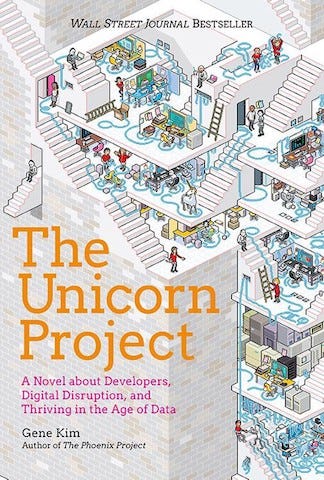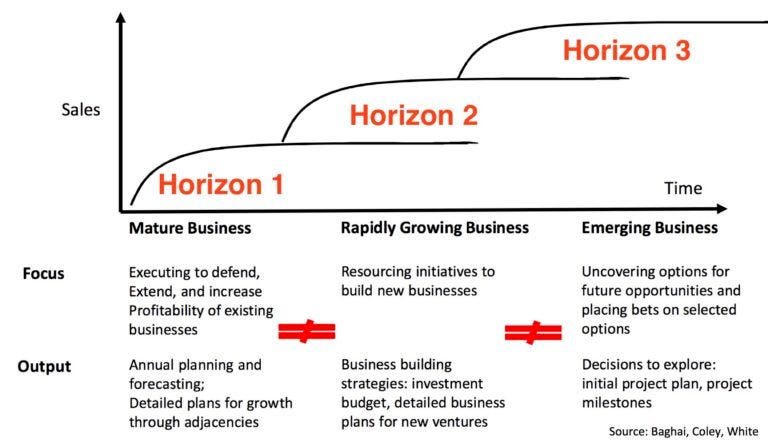Review and notes from The Unicorn Project by Gene Kim
“The illiterate of the 21st century will not be those who cannot read and write, but those who cannot learn, unlearn, and relearn.

Over the past few months, I read several books that have helped me develop a better understanding of how modern technological industries function. The Unicorn Project was an odd one out. This is primarily because it is a tech industry centered novel. I was completely absorbed in the story and its lessons. This article focuses on 2 important findings the book helped me understand. If you are interested in reading the book you can find it here.
5 Ideals of Production and Deployment
Five Ideals can be considered as the building blocks of any successful organization. They might sound abstract but they’re nowhere near that. The ideals are clear and helpful in understanding the core of a thriving company.
1. 🗺️ Locality and 🔤 Simplicity
We need to design things so that we have locality in our systems and the organizations that build them. And we need simplicity in everything we do. The last place we want complexity is internal, whether it’s in our code, in our organization, or in our processes. The external world is complex enough, so it would be intolerable if we allow it in things we can actually control! We must make it easy to do our work. The benefits of this ideal is that it will enable
2. 🧠 Focus, 🌊 Flow, and 🙌 Joy
It’s all about how our daily work feels. Is our work marked by boredom and waiting for other people to get things done on our behalf? Do we blindly work on small pieces of the whole, only seeing the outcomes of our work during deployment when everything blows up, leading to firefighting, punishment, and burnout? Or do we work in small batches, ideally single-piece flow, getting fast and continual feedback on our work? These are the conditions that allow for focus and flow challenge, learning, discovery mastering our domain, and even joy.
3. 🕓 Development of Daily Work
It is ignorance that is the mother of all problems, and the only thing that can overcome is learning. — Dr. Steven Spear
It is the dynamic that allows us to change and improve how we work. One example, the Toyota Andon cord teaches us about how we must elevate the improvement of daily work over daily work itself. This is one of the most studied cases of a learning organization. When anyone, encounters a problem, everyone is expected to ask for help anytime, even if it means stopping the entire assembly line. And they are thanked for doing so because it is an opportunity to improve daily work. As result problems are quickly seen, swarmed, and solved, and those learnings are spread far and wide so all may benefit. For a leader or any influential member of an organization, they may have to take tough decisions such as changing old rules that don’t apply anymore and how they organize people (ergonomics, social mobility). Overall, for them, it means guiding, enabling, and removing obstacles rather than directing or controlling. Most importantly, it requires an understanding of the vision and the intellectual stimulation to question the basic assumptions of how work is done.
(An opposite of this is someone who values process compliance and the phrase “The way we’ve always done it”. Picture a huge library of rules and regulations, processes and procedures, approvals, and stage gates with new rules being added all the time to prevent the latest disaster from happening.)
4. 💜 Psychological Safety
We make it safe to talk about problems, because solving problems requires prevention, which requires honesty, and honesty requires the absence of fear. In manufacturing, psychological safety is just as important as physical safety.
The process of creating conditions that enable psychological safety can be tenuous and letting. This is because it largely depends on the behavior of leaders, one’s peers, their moods, and their sense of self-worth (also would from the past..). But it’s not impossible.
5. 👁️ Customer Focus
We should ruthlessly question whether something actually matters to our customers, as in, are they willing to pay us for it, or is it only of value to our functional silo? When it comes to Customer Focus we should approach it as being customer-centric instead of being silo-centric (A [silo](https://www.investopedia.com/terms/s/silo-mentality.asp) mentality is a reluctance to share information with employees of different divisions in the same company). In a company where multiple applications and services being managed, ask the question that which of them are customers willing to pay you for? Which ones truly enhance competitive advantage? And which can you rely on vendors for?
Example:
A hundred years ago, most large factories has a CPO a Chief Power Officer — who ran the electricity generation processes. It was one of the most important roles in manufacturing, because no electricity, no production. It was a Core process. But that role has disappeared entirely. Electricity has become an infrastructure that you buy from a utility company. It is interchangable, and you choose suppliers primarily on price. There is rarely a competitive advantage to generating your own power. It is now merely context no longer the Core. We don’t want to be an organization that has a large staff providing internal power generation.
One keeps what is not good enough and outsources what is more than good enough.
There’s also a very good article and presentation that dive into the Five Ideals. You can find it here.
Horizons (one..two..three)
The concept of Horizons 1,2 and 3 was popularized by Dr. Geoffrey Moore in his book,* “Crossing the Chasm”. *The book introduced the customer adoption curve into modern business planning.
Quick Intro to Customer Adoption Curve:
](https://cdn-images-1.medium.com/max/2000/1V36CogJREZZITC1CmZe3JQ.jpeg)Source: [How the Adoption Curve Impacts Your Education Marketing Strategy, Lauren Reid](https://www.cblohm.com/blog/education-marketing-trends/adoption-curve-education-marketing-strategy/)
The customer adoption curve (Also known as the product adoption curve( **is a standard model that reflects who buys your products and when. Think of it as the big picture view of your product **adoption. It takes the product lifecycle and considers what happens at different points. Like I mentioned, this curve shows you who buys your products and when. You can read more about it here. One of Dr. Geoffrey Moores’ observation was that the customer adoption is a Gaussian distribution curve which can be divided into classes of innovators/enthusiasts, early adopters/visionaries,* early majority/pragmatists, *late majority/conservatives and laggards/skeptics.
This is a good way to better organize how to approach the idea of Three Horizons, so let’s dive into is. At this point in time, FAANGM companies have gone way beyond the idea of the three Horizons (Although on a grass root level, they follow the same concept) because they have the capital and creative manpower to broaden their reach.
For this article let’s look at a fictional company and call it Car Ustaads (Ustaad means teachers in Urdu), ( I am also very bad with creative names).
 Source: Innovating Across Three Horizons** by Nina Simosko** (Couldn’t find the main reference)
Source: Innovating Across Three Horizons** by Nina Simosko** (Couldn’t find the main reference)
Horizon 1
This is our successful, cash-cow businesses, where the customer, business, and operational models are well known and predictable. The Horizon 1 venture for Car Ustaad is its parts delivery and maintenance service, which provides customers with on-spot car maintenance, Prime-like delivery/pick up service for emergency parts, and overall they are well-established in this area with shops around the country of Wakanda (RIP Chadwick Boseman 💔).
The problem with having Horizon 1 as a lone source of revenue is that, since they’re well established, there will always be fierce attacks by competitors, hoping to grab a piece of the revenue by ruthless innovation in their own products. In such a fierce market, businesses that try to anchor around a single product fade over time, as they will attract competitors. Also, from an economics perspective telling reductions in transactional costs is irresistible and inevitable. So what should Car Ustaad do?
Horizon 2
Instead of heavily investing and neutralizing the potential competitors, Cars Ustaad should focus on creating and investing in products that highlight the future of the company. For example, introducing the companies capabilities to new customers, adjacent markets, or with different business models. It is important to note that Car Ustaad might not find profit in these endeavors but that is not the sole point of creating a thriving organization. What we are trying to do with a Horizon 2 model is to find and map out the potentially high-growth areas. These areas can eventually become an addition to the Horizon 1 line.
An example would be Car Ustaads, developing a robust interconnected digital database system and introduce devices that let customers track the conditions of the car in more depth. Car Ustaads might dive into using an Internet of Things (IoT) model and design (or just buy from China) smart engine sensors with a real-time status update app. This will help them develop a stronger relationship with the customer.
Horizon 3
So since we have basically given a blueprint of the current and potential future products of the company, where does Horizon 3 fit in? Well, Horizon 2 is actually a byproduct of the efforts made in Horizon 3. Over here the focus will be on generating a learning environment where a broad pool of ideas can be explored (essentially a Research and Development mechanism). The goal is to prototype ideas and to be able to answer three main aspects of any product:
-
Market risk
-
Technical risk
-
Business model risk
Possible questions we can ask are:
-
Does the idea solve a real customer need?
-
Is it technically feasible? or
-
Is there a financially feasible, engine of growth.
If we are unable to find a reasonable answer that is in favor of the organization, it’s better to change our approach to kill the idea. However, if an answer with a yes, then the idea can go through a continuous process of development until is ready to be moved up to Horizon 2.
The most crucial way to approach Horizon 3 is by being fast. We must constantly be experimenting and we must be allowed to break all the rules and processes, governing Horizon 1 (in short fast iterations, lots of bets, and doubling down on the winning ideas).
Overall this is where new methods are forged and mastered which will likely help the organization survive into the future.
If you want to read a more in-depth understanding of what the Horizons planning should focus on, refer to this [article by Nina Simosko](https://www.ninasimosko.com/2016/06/28/innovating-across-three-horizons/).
Conclusion
Although the book has a lot more to offer, I believe these two areas are crucial for entrepreneurs who want to build a solid foundation for their company. It is also essential for workers who want to be a part of a great organization that is helping in making a better culture for its employees and also a better world for its customers.
If you have any questions or would like to discuss this book in more detail you can contact me on shayanariyaz@gmail.com or on Twitter @ShayanRiyaz.
